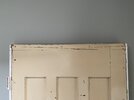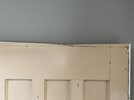Rookie mistake! I need to trim the bottom off an old wooden internal door due to new carpets. I used a jigsaw with a guide clamped to the door and thought I’d done a great job until I realised the underside had veered inwards and taken a chunk out that I didn’t need! Lovely straight line on top though 
I’ve realised I probably should have invested or borrowed a circular saw but moving forwards I can only see two options.
I know a new door would probably be easier but they are the original 1930’s doors we are trying to restore. Any ideas welcome
I’ve realised I probably should have invested or borrowed a circular saw but moving forwards I can only see two options.
- Make good and cut new straight line at the deepest point but this could leave the door with a large gap.
- Glue and screw the cut off section back on and then, using a circular saw and guide, cut off the original intended bit again, leaving the unintended piece then still glued and screwed in. Then fill, sand etc.
I know a new door would probably be easier but they are the original 1930’s doors we are trying to restore. Any ideas welcome




